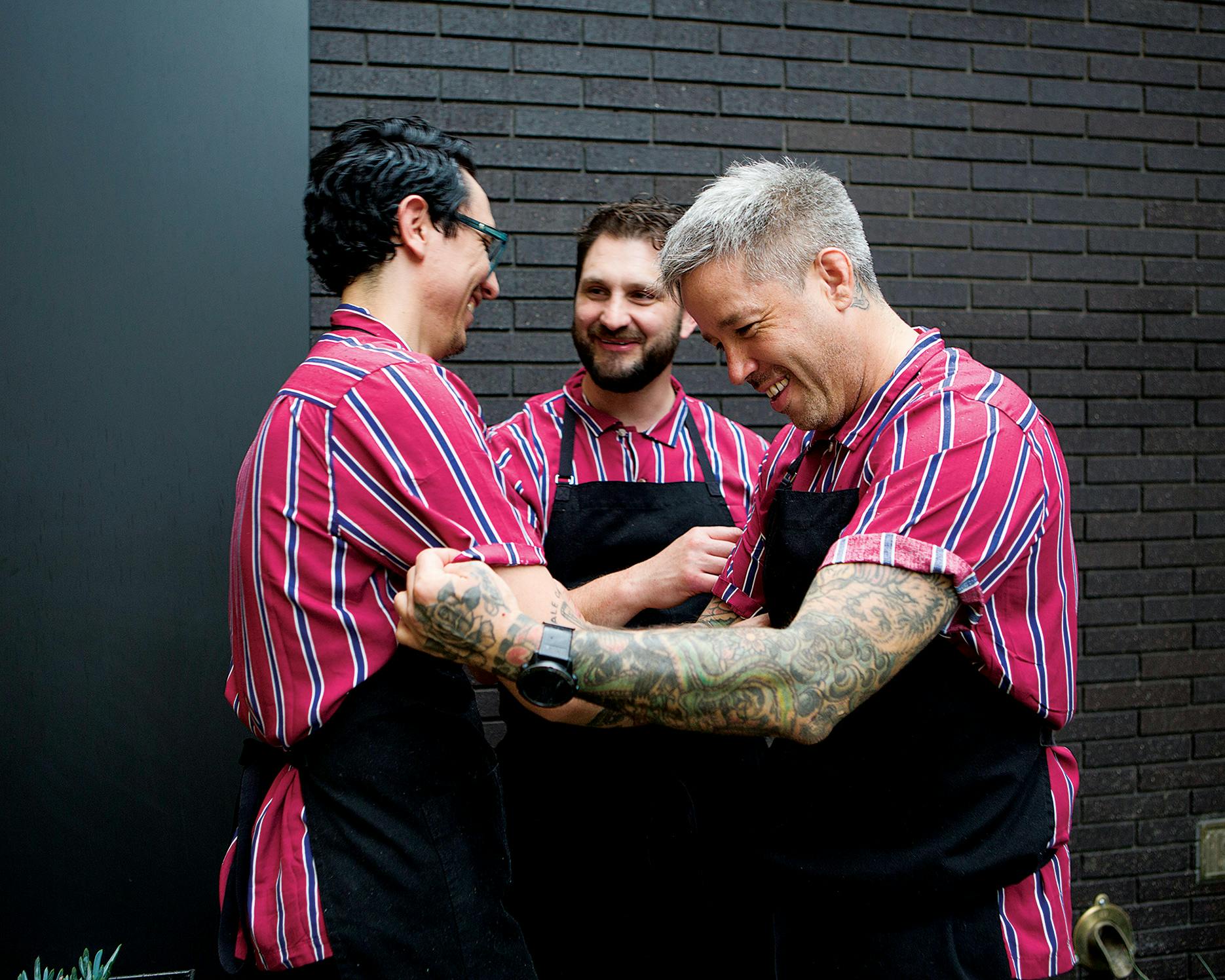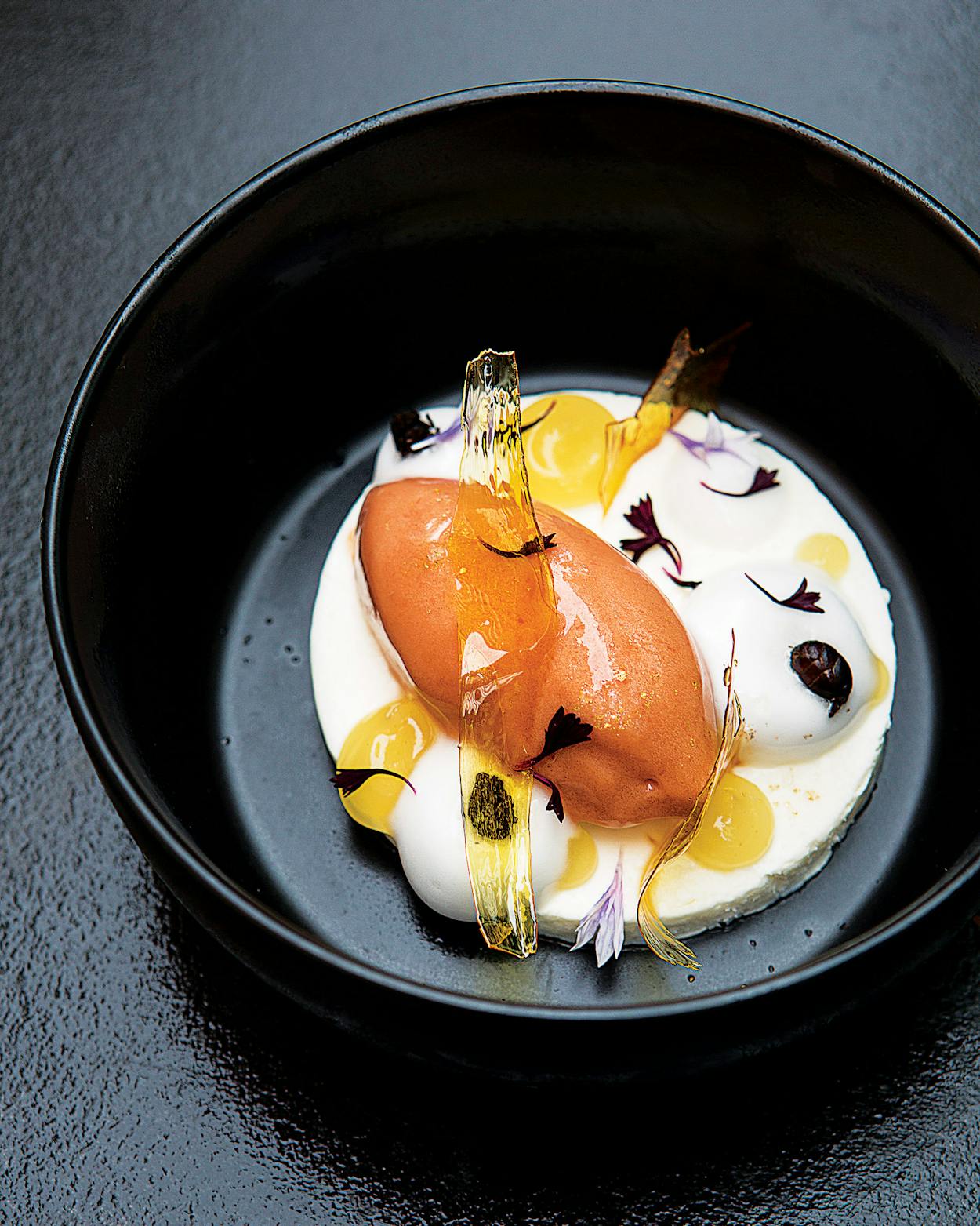What is this place? An art gallery? A tech start-up? I’m standing outside a mysterious new building in downtown Austin’s Warehouse District, its exterior veneered in black steel plate and glass bricks. Affixed to the wall are curvy brass letters that seem to spell out a name, but it’s indecipherable too. Suddenly, the door opens to reveal a long, narrow courtyard filled with fat green barrel cacti and a lacy paloverde tree. Parallel to the open space is a soaring dining room where shafts of light pour through a bank of industrial-looking windows that bring the sky inside. Ah, it’s becoming clear: the place is a restaurant—specifically, Austin’s restaurant of the moment, Comedor.
The hive mind behind this modern Mexican enterprise is a trio of Texas chefs led by Philip Speer, most recently of Austin’s now-closed French cafe Bonhomie (and prior to that the Uchi Japanese group, where he built a reputation for creating mind-blowing desserts). The second is Gabe Erales, who, among other gigs, cooked at René Redzepi’s Noma, in Copenhagen, and helped launch that chef’s famous 2017 Mexican pop-up outside Tulum. The third is Alan Delgado, the chef at Austin’s now-shuttered elite tasting-menu venue Counter 3 FIVE VII.
What is the operating philosophy at work at Comedor? (By the way, the word means “dining room” and is pronounced “ko-meh-dor.” Please don’t call it “commodore.” Please.) Given the three principals’ border connections—Speer is from McAllen, Erales and Delgado from El Paso—it’s no surprise to find that they bring a highly personal take on Mexican cuisine. The ideas at play here are as cutting-edge as any that you’ll find at Mexico City’s Pujol or Quintonil. At the same time, there are techniques and flavors that date back centuries, a legacy of the many indigenous people of Mexico, as well as the Spanish and French colonists who arrived later.

You will probably want to begin with something liquid. If so, might I suggest the jalapeño-cucumber-tequila cocktail, which is bright, not too sweet, and goes extremely well with a light starter like the aguachile. This quick-marinated cousin of ceviche is getting a lot of exposure these days and is treated simply here. The seafood—fluke on our visit—gets a citrus bath, then a fun bit of crunch in the form of popped wheat berries and slices of salt-cured charred cucumber. Another nice nibble is the arty diver scallop crudo, silken wafers of plump white shellfish mellowed by a generous splash of a traditional fermented pineapple broth called tepache.
Following that, you might turn to the basics, like, for instance, anything made with masa. We could have chosen a goat barbacoa tamal, but instead we went for the quesadilla. The outer tortilla wrapper was made with house-milled blue corn, and it was fantastic. The filling was fresh, earthy-sweet huitlacoche—a.k.a. corn fungus. And then there was the finishing touch, a green jacket of anise-scented hoja santa leaf that Erales foraged from Barton Creek—now, that’s local. If only the accompanying smoked Fresno chile salsa hadn’t been so acidic, it would have been perfect.
Speaking of basics, I’m not sure how to sum up the bean dish we liked so much. A cross between a stew and a hearty porridge, it was a happy mix of multiple heirloom beans along with Texas mushrooms and adorable masa dumplings called chochoyotes. The occasional fried bean had been stirred in for texture, and a bed of pureed avocado added an almost supernatural smoothness.
But the make-or-break element of any interior Mexican restaurant is its mole repertoire, and I was curious to see how these sauces would turn out. My favorite was a light, sweet, chile-based mole served with chunky butternut squash topped with sweet-potato crisps. And I was not un-fond of the classic mole rojo on the fried quail milanesa, a base of chile ancho softened by allspice and oregano. But the one I had the highest hopes for turned out to be the iffiest—a green pumpkin-seed mole overwhelmed by kale, epazote, cilantro, and hoja santa. It was a dish that only a health freak could love.

But no matter what else you get, dessert is a must. For pure audacity, I marveled at the black-cocoa chocolate tamal, a compact masa ball filled with ganache, like a molten chocolate cake, but the one I truly loved was an ivory white chamomile mousse (it tastes exactly like the comforting tea). Alongside was a sharp, sweet pink guava sorbet, and strategically placed on top was a garnish of—get ready—three of Oaxaca’s famous chicatana ants. Don’t worry; they’re mainly salty and spicy. Their greatest asset is crunch. And Instagram appeal.
For many decades, Mexican classics have been Texas’s designated comfort food. Speer understands that. After all, who doesn’t love a good taco or enchilada plate? But it also exasperates him to no end. “The more I learn about the complexity of Mexican food,” he says, “the more frustrated I get when people want it to be cheap and limited to a few ingredients.” Now that he’s doing a deep dive into Mexico’s multifaceted cuisine, he’s become a passionate advocate for an alternative reality, or at least a parallel universe. “The truth,” he says, “is that the techniques are complex, the ingredients endlessly varied, and the results sophisticated, with layers and layers of the most amazing flavors.” With Comedor, he and his partners are out to bring that point home.
Comedor
501 Colorado, Austin
512-499-0977
Dinner Mon–Sat.
$$$
Opened April 16, 2019
Visit comedortx.com
This article originally appeared in the June 2019 issue of Texas Monthly with the headline “Something Old, Something New.” Subscribe today.
- More About:
- Pat’s Pick
- Mexican Food
- Austin









